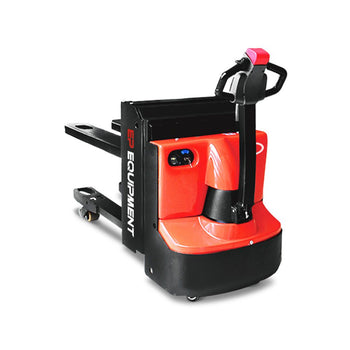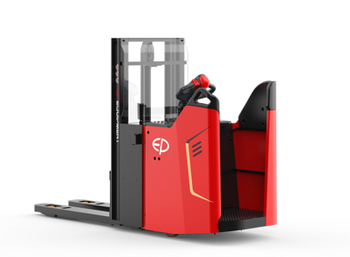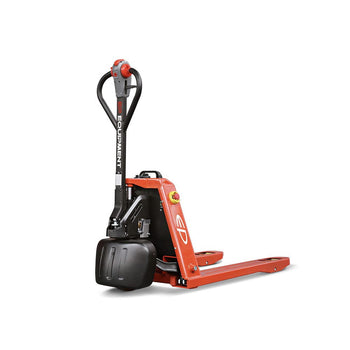Material‑handling is the backbone of every warehouse, distribution centre and retail space. Pallet trucks – sometimes called pallet jacks – are one of the simplest yet most important pieces of material‑handling equipment. These two‑pronged vehicles allow a single operator to lift and move a loaded pallet safely and quickly. When deciding between a manual pallet truck and an electric pallet truck, businesses must weigh not only purchase price but also productivity, ergonomics, safety and long‑term return on investment (ROI). This article compares the two technologies side‑by‑side and explains when upgrading to electric makes financial and operational sense.
Understanding the Technology
Manual pallet trucks
A manual pallet truck uses a simple hydraulic pump and drawbar to lift pallets. The operator slides the forks under a pallet, pumps the handle to raise it and then pushes or pulls the load to the destination. Manual trucks are extremely common because they are low‑cost, compact and reliable. Cherry’s Material‑Handling notes that manual pallet trucks are significantly less expensive than powered models, have no engine and fewer components, require little training to operate and generally need little maintenance. Typical capacities range from around 4,400–5,500 lb (2,000–2,500 kg), but in practice operators comfortably handle loads closer to 2,500 lb or less.
Electric pallet trucks
Electric pallet trucks (also called walkie pallet jacks) add a battery‑powered drive motor and electric lift motor to the basic pallet truck design. The operator uses a throttle on the tiller to propel the truck and raises or lowers the forks with a button. Electric jacks typically carry 4,500–6,000 lb and travel at about 2.5–3.5 mph. Because they are driven rather than pushed, electric trucks can handle mid‑distance runs, ramps and heavier loads with much less physical effort. Electric models also often include ergonomic controls, power steering, ride‑on platforms and safety features like belly‑bumper stop buttons, anti‑rollback brakes and speed governors.
Operational Efficiency and Productivity
Distance and speed
A key difference between manual and electric pallet trucks is the distance and speed they can comfortably handle. Manual trucks rely on human power; on short runs of up to roughly 40 ft (12 m) a manual jack is efficient, but longer distances quickly fatigue the operator. Cherry’s Material‑Handling states that manual jacks are ideal for hauls up to 40 ft, while electric jacks are more effective between 40 and 100 ft. Thompson & Johnson refine this guidance, suggesting manual jacks are best for runs of 50–75 ft and infrequent moves, while electric jacks shine for frequent moves and longer hauls. Electric jacks also travel faster; travel speeds around 3 mph save minutes per cycle compared with walking speed.
Load handling and throughput
Manual jacks can technically lift similar weights to electric units, but their capacity is limited by human strength. Operators can struggle with loads above ~2,500 lb on smooth floors and may require assistance on inclines. Manual jacks also cannot quickly stop a moving load on a slope; Cherry’s warns that a manual jack should not be used on an incline without a helper because a runaway load can cause serious injury. Electric jacks can climb grades and hold on slopes thanks to powered wheels, electric brakes and anti‑rollback systems. They move heavy loads with the flick of a switch, drastically reducing cycle time and operator fatigue.
In high‑volume operations the speed difference compounds. The TCM blog notes that electric pallet trucks maximise productivity with fast charging, high travel speeds and reduced manual tasks. Electric units allow operators to ride or stand on a platform and move multiple pallets quickly, which is ideal for long picking runs or shuttling goods across large facilities. Thompson & Johnson’s rule of thumb is that if workers push more than a few dozen pallets per shift or travel more than ~75 ft per move, an electric pallet truck typically wins on total cost of ownership. Manual jacks remain efficient for occasional tasks, tight manoeuvring in trailers or aisles and as backup equipment.
Space and manoeuvrability
Manual pallet trucks are compact and can be stationed almost anywhere in a warehouse, making them extremely accessible. Their small footprint allows them to navigate narrow aisles and turn in tight spaces. Electric pallet trucks are larger because of the battery, motor and, sometimes, ride‑on platform. However, modern designs still offer a relatively compact chassis. TCM points out that electric trucks are highly manoeuvrable and suited for tight aisles and stock‑floor replenishment. The ability to rotate and change direction with power steering can improve control in congested areas.
Safety and Ergonomics
Musculoskeletal strain and injury risk
Manual pallet trucks reduce the need to lift loads manually, but they still require significant pushing, pulling and pumping motions. Over long distances or with heavy loads, these forceful exertions can lead to musculoskeletal injuries such as strains, sprains and repetitive strain injuries. The OSHA Training School notes that improper lifting and overexertion when using hand pallet trucks can strain back muscles and lead to shoulder dislocation or foot injuries. It warns that collisions or rollovers can occur if operators are inattentive. SafetyVideos.com adds that palletized loads pose ergonomic challenges such as heavy components, awkward postures, twisting and bending; these factors combine to cause musculoskeletal disorders. Hidden costs include lost productivity, workers’ compensation claims and the expense of rehiring and training staff to replace injured workers.
Electric pallet trucks eliminate much of the physical exertion associated with manual models. Cherry’s notes that electric trucks are “far easier on operators” because human power is replaced by electric energy, reducing musculoskeletal strain. TCM emphasises that reduced or eliminated manual tasks minimise operator strain and promote a healthy working environment. Ergonomic handles, power steering and ride‑on platforms allow operators to work comfortably without repetitive pushing or pumping. Better control reduces the likelihood of awkward postures, twisting and bending. Electric jacks also often incorporate safety features such as emergency stop buttons, anti‑rollback systems and speed controls.
Visibility, noise and emissions
Electric pallet trucks improve warehouse conditions in other ways. Modern electric trucks are environmentally friendly because they release no exhaust fumes and operate quietly. Reduced noise improves communication and reduces hearing‑related injuries. Electric trucks often have better visibility and lighting, making it easier for operators to spot hazards. Manual jacks lack such integrated systems and rely entirely on operator vigilance.
Training and regulatory considerations
Manual pallet trucks require minimal training because their operation is straightforward. Any employee can use them without special certification. Electric pallet trucks, however, are regulated as powered industrial trucks in many jurisdictions. OSHA requires operators to receive training and evaluation before using powered pallet jacks. This training adds cost and time but improves safety by ensuring proper use. Thompson & Johnson emphasises the importance of formal training on electric jacks, including awareness of walkie‑specific hazards and safe speed settings. Proper training prevents accidents and ensures compliance with safety regulations.
 Cost Analysis and Total Cost of Ownership
Cost Analysis and Total Cost of Ownership
Purchase price
rice is the most obvious difference between manual and electric pallet trucks. Manual pallet jacks are the cheapest option; they typically cost under about £370. Electric pallet trucks cost significantly more; typical purchase prices range from roughly £1,480 to £4,440, depending on capacity and features. Electric jacks carry a higher upfront price, and premium brands command an even steeper price tag.
Operating and maintenance costs
Manual pallet trucks have almost no running costs: they use human energy, and maintenance involves greasing, replacing wheels and seals, and occasional hydraulic oil changes. Because there are few moving parts, repairs are simple and inexpensive. Source 4 Industries explains that manual jacks are generally less expensive to maintain and do not require specialised mechanics.
Electric pallet trucks incur additional operating costs. They require batteries, chargers and a charging area. Operators must plug them in for several hours to recharge, resulting in downtime. Batteries and motors have finite lifespans and must eventually be replaced. Electric trucks also have more complex components (motors, electronic controls, brakes) that require periodic servicing by trained technicians. This maintenance cost is higher than for manual units. However, lithium‑ion technology is reducing maintenance downtime; Li‑ion batteries can be rapidly charged and have minimal moving parts, reducing maintenance needs.
Labour costs and hidden costs
The largest component of total cost of ownership is labour. Manual pallet trucks slow down operations because operators must walk and push loads. Hidden costs include slower throughput and fatigue, which can reduce worker productivity over a shift. Manual jacks demand considerable physical exertion and are less efficient over long distances. Cherry’s warns that manual jacks require significant force to move heavy loads, contributing to injuries and fatigue. The OSHA Training School lists back injuries, shoulder dislocations and foot injuries among the risks; a single shoulder surgery could exceed the cost of an electric pallet truck. These hidden costs – lost work time, workers’ compensation claims and turnover – can be significant.
Electric pallet trucks increase labour efficiency. They reduce cycle times because they travel faster and require minimal physical exertion. Operators can move more pallets per shift and experience less fatigue. Source 4 Industries observes that powered jacks offer a better long‑term ROI because their efficiency and reduced labour costs offset the larger upfront investment. Thompson & Johnson summarises this trade‑off succinctly: while manual jacks have the lowest acquisition cost, hidden costs appear as slower moves and operator fatigue; electric jacks have higher initial costs but beat manual units on labour efficiency when moves are frequent or distances are long.
Total cost of ownership and ROI
Calculating ROI involves comparing the savings from increased productivity and reduced injury costs against the higher purchase and maintenance costs of electric equipment. For example, assume a manual jack costs £370, while an electric jack costs £1,480. If the electric jack allows an operator to move pallets twice as quickly and to avoid injuries that could cost thousands of dollars, the payback period can be short in high‑volume operations. Thompson & Johnson offers a rule of thumb: if operators handle more than a few dozen pallets per shift or travel more than ~75 ft per move, electric typically wins on total cost of ownership. Wolter Inc. points out that a single shoulder surgery due to manual pallet jack strain can exceed the cost of an electric pallet truck. Businesses should therefore include injury risks and labour efficiency in ROI calculations, not just the price of the equipment.
Decision Criteria: When Does Each Type Make Sense?
The decision between manual and electric pallet trucks depends on several factors:
| Factor | Manual Pallet Truck | Electric Pallet Truck |
|---|---|---|
| Upfront cost | Low (≈£150–£450); allows multiple units to be deployed cheaply | Higher (≈£1,500–£4,500); may require financing |
| Maintenance & operating cost | Minimal; no fuel or charging; simple maintenance | Requires battery charging, replacement, and specialised servicing |
| Distance & frequency of use | Best for short runs (≤50–75 ft) and infrequent or seasonal use | Efficient for long hauls, multi-shift work, and frequent moves |
| Load capacity | Rated up to 4,400–5,500 lb, but practical loads around 2,500 lb | Similar or higher rating (4,500–6,000+ lb) and maintains consistent push/pull force regardless of load |
| Space requirements | Compact, ideal for tight aisles and as backup equipment | Larger but still manoeuvrable; ride-on models free operators from walking long distances |
| Ergonomics & safety | Operator exerts physical force → fatigue, musculoskeletal injuries, and risk of runaway loads on slopes | Reduces physical exertion and injury risk; ergonomic controls, emergency stops, and slope holding |
| Training & regulation | Simple operation; minimal training; anyone can use | Requires OSHA-compliant training and certification |
| Environmental impact | Human-powered; no emissions; very quiet | Battery-powered; no exhaust fumes; quieter than internal-combustion equipment |
| Best applications | Small warehouses, retail stores, tight spaces, occasional loads, budget-conscious operations | Large warehouses, distribution centres, frequent picking, heavy loads, ramps, and docks |

Making the Upgrade Decision
Businesses considering an upgrade should analyse their specific operation. Key questions include:
-
How far and how often are pallets moved? If employees move pallets sporadically across short distances, manual pallet trucks may suffice. If each shift involves dozens of moves over hundreds of feet, electric trucks can save time and labour.
-
What are the load characteristics? Light to moderate loads on smooth floors can be handled manually. Heavy or bulky items, ramps, dock plates and slopes favour electric units due to their powered wheels and brakes.
-
What is the workforce’s condition? High turnover, rising labour costs or concerns about musculoskeletal injuries support investing in equipment that reduces physical strain. According to OSHA, injuries like back strains and shoulder dislocations are common with manual pallet jacks, and one serious injury can cost more than an electric jack.
-
What infrastructure is available? Manual pallet trucks require no charging area. Electric trucks need charging stations, battery management and possibly spare batteries to support multi‑shift use. Lithium‑ion batteries with opportunity charging minimise downtime, but planning is still essential.
-
Budget and long‑term strategy: Upfront budget constraints may lead to manual trucks, but consider the overall ROI. Electric pallet trucks often pay for themselves through reduced labour and injury costs over time. Leasing or financing options can spread the expense.
Conclusion
Manual and electric pallet trucks each have a place in modern material‑handling operations. Manual jacks offer simplicity, low cost, minimal maintenance and manoeuvrability, making them ideal for small warehouses, occasional moves and budget‑conscious businesses. However, they rely on human strength, limiting their efficiency and exposing operators to musculoskeletal injuries. Electric pallet trucks cost more up front, require training and charging infrastructure, and have more complex maintenance. In return, they provide faster travel, consistent power, superior ergonomics and advanced safety features that increase throughput and reduce injury risk.
When evaluating whether to upgrade, managers should look beyond sticker price. Consider the number of pallets moved, the distances involved, worker fatigue, injury statistics and hidden costs. In high‑volume operations, the labour savings and safety benefits of an electric pallet truck can deliver a compelling ROI and help build a safer, more efficient warehouse. In smaller, low‑volume settings, manual pallet trucks remain a cost‑effective and reliable choice. By aligning equipment choices with operational demands, businesses can maximise productivity, protect employees and make informed investments in their material‑handling fleets.





